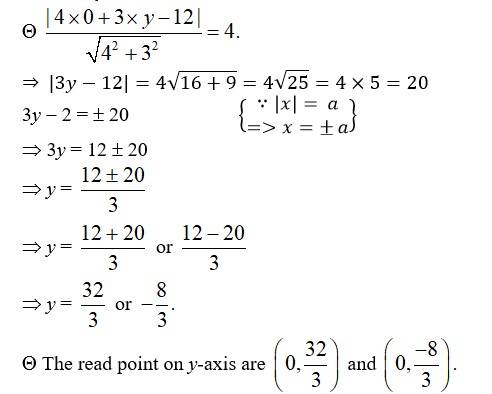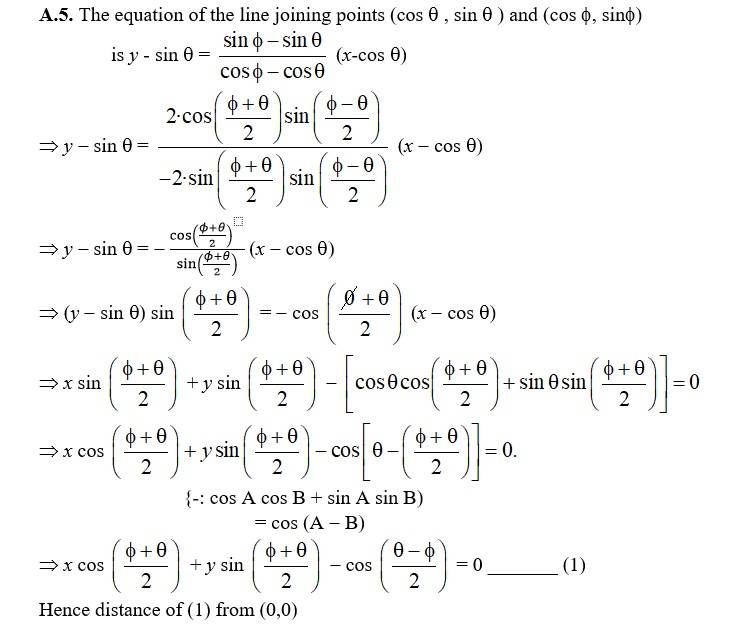Maths
Get insights from 6.5k questions on Maths, answered by students, alumni, and experts. You may also ask and answer any question you like about Maths
Follow Ask QuestionQuestions
Discussions
Active Users
Followers
New answer posted
6 months agoContributor-Level 10
A = N * N
* is a binary operation on A and is defined by:
(a, b) * (c, d) = (a + c, b + d)
Let (a, b), (c, d) ∈ A
Then, a, b, c, d ∈ N
We have:
(a, b) * (c, d) = (a + c, b + d)
(c, d) * (a, b) = (c + a, d + b) = (a + c, b + d)
[Addition is commutative in the set of natural numbers]
∴(a, b) * (c, d) = (c, d) * (a, b)
Therefore, the operation * is commutative.
Now, let (a, b), (c, d), (e, f) ∈A
Then, a, b, c, d, e, f ∈ N
We have:
Therefore, the operation* is associative.
An element will be an identity element for the operation* if
which is not true for any element in A.
Therefore, the operation* does not have any identity
New answer posted
6 months agoContributor-Level 10
24. (i) f(x)=2 – 3x, x R, x>0.
Given, x>0
3x>3 * 0
3x>0
(–1) * 3x<(1) * 0.
–3x<0
2 – 3x<0+2
2 – 3x<2
i.e., f(x) < 2
Hene, range of f(x) = (– ?, 2)
(ii) Given, f(x) = x2+2, x is a real number.
Since, x is a real number,
x2 ≥ 0 (x2=0 for x=0)
x2+2 ≥ 0+2
x2+2 ≥ 2
f(x) ≥ 2
?Range of f(x) = [2, ?)
(iii) Given, f(x) = x, x is a real number.
As, f(x) = x, the range of f(x) is also real.
i.e., Range of f(x) = R.
New answer posted
6 months agoContributor-Level 10
Let the identity be I.
An element will be the identity element for the operation* if
We are given
Similarly, it can be checked for , we get e=4. Thus, e=4 is the identity
New answer posted
6 months agoContributor-Level 10
(i) On Q the operation* is defined as a*b=a-b.
It can be observed that:
Thus, the operation* is not commutative.
It can also be observed that:
Thus, the operation* is not associative.
(ii) On Q the operation* is defined as a*b=a2+b.
For , we have:
Thus, the operation* is commutative.
It can be observed that:
Thus, the operation* is not commutative.
(iii) On Q the operation* is defined as a*b=a+ab.
It can be observed that:
Thus, the operation* is not commutative.
It can also be observed that:
Thus, the operation* is not associative.
(iv) On Q the operation* is defined as a*b=(a-b)2
For , we have:
Thus, the operation* is commutative
New question posted
6 months agoNew answer posted
6 months agoContributor-Level 10
58. Let (0, y) be the point on y-axis which is at a distance 4 unit from the line
Then, the line
4x + 3y = 12.
4x + 3y - 12 = 0

New answer posted
6 months agoContributor-Level 10
The binary operation * on N is defined as:
a * b = H.C.F. of a and b
It is known that:
H.C.F. of a and b = H.C.F. of b and a & mn For E; a, b ∈ N.
∴a * b = b * a
Thus, the operation * is commutative.
For a, b, c ∈ N, we have:
(a * b)* c = (H.C.F. of a and b) * c = H.C.F. of a, b, and c
a * (b * c)= a * (H.C.F. of b and c) = H.C.F. of a, b, and c
∴ (a * b) * c = a * (b * c)
Thus, the operation * is associative.
Now, an element e ∈ N will be the identity for the operation * if a * e = a = e* a ∈ a ∈ N.
But this relation is not true for any a ∈ N.
Thus, the operation * does not have any identity in N.
New answer posted
6 months agoContributor-Level 10
57. Let a and b be the x & y intercept. Then,
_____ (1)
Given, a + b = 1. ______ (2) b = 1 -a _____ (3)
and ab = -6 _____ (4)
Putting eqn (B) in (iii) we get a
a (1- a) = - 6
a - a2 = - 6
a2 - a - 6 = 0
a2 + 2a - 3a - 6 = 0
a (a + 2) - 3 (a + 2) = 0
(a + 2) (a -3) = 0
(a + 2) (a -3) = 0.
a = 3 or a = -2.
When a = 3, b = 1- a = 1 - 3 = - 2
When a = - 2, b = 1 - (-2) = 1 + 2 = 3
So, (a, b) = (3, -2) and (-2, 3)
Hence, eqn (1) becomes,
and
2x – 3y = 6 and 2y - 3x = 6
Gives the read eqn of lines
New answer posted
6 months agoContributor-Level 10
The operation * on the set A = {1, 2, 3, 4, 5} is defined as
a * b = L.C.M. of a and b.
Then, the operation table for the given operation * can be given as:
* | 1 | 2 | 3 | 4 | 5 |
1 | 1 | 2 | 3 | 4 | 5 |
2 | 2 | 2 | 6 | 4 | 10 |
3 | 3 | 6 | 3 | 12 | 15 |
4 | 4 | 4 | 12 | 4 | 20 |
5 | 5 | 10 | 15 | 20 | 5 |
It can be observed from the obtained table that:
3 * 2 = 2 * 3 = 6 ∉ A, 5 * 2 = 2 * 5 = 10 ∉ A, 3 * 4 = 4 * 3 = 12 ∉ A
3 * 5 = 5 * 3 = 15 ∉ A, 4 * 5 = 5 * 4 = 20 ∉ A
Hence, the given operation * is not a binary operation.
Taking an Exam? Selecting a College?
Get authentic answers from experts, students and alumni that you won't find anywhere else
Sign Up on ShikshaOn Shiksha, get access to
- 65k Colleges
- 1.2k Exams
- 679k Reviews
- 1800k Answers


